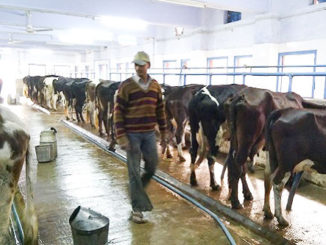Internal parasites cause many ill affects among the ruminants and domestic animals. They cause severe economic losses to the animal husbandry in a numerous ways. Heavy endoparasitic load in animals leads to anemia, inappetance, diarrhoea, poor hide quality, emaciation and many more adverse affects which may lead to death if not attended timely. So, it becomes important to deworm the animal in the herd during the susceptible i.e., extreme season wherein there is high risk of presence of parasitic stages in our surroundings. Monsoon season is more favourable for the development of various stages of endoparasites. High rainfall, humidity and salinity of salt are the important factors which affects the internal parasitic infection in animals. Contaminated feed and water, overcrowding and poor farm hygiene are directly related to high parasitic infections.
In India, there is a regular practice of deworming each and every animal in the herd whether harbouring parasites or not. It has become tradition of deworming the whole population of animals. This method of deworming washes out all the refugia population (includes the parasite which avoids development of anthelminthic resistance) and hence resulting in high risk of the anthelminthic resistance among the ruminants. Deworming of all the animals in herd also causes wastage of deworming agent in large scale. To tackle this issue now a days a new concept of targeted selective treatment is coming into existence, which means deworming is done in animals only when needed and thus resulting in effective treatment. This includes a decision making tool namely five point check which has become popularized mainly among the small ruminants in abroad countries America, Australia. This helps in delay of development of anthelminthic resistance.
Five points check allows us to know the need of deworming by considering certain criteria in the animal. And each criteria has its own significance and indicates the presence of one or the other specific parasite.
Here five points looked in sheep are:
- Eye mucous membrane- this indicates the status of anemia in the animal and subsequently the presence of the blood feeding or sucking parasites such as Heamonchus, hooks worms etc. Anemia is caused by blood feeding parasites which is estimated by evaluating the colour of lower eyelid.
- Nostrils- the discharge from the nasal cavity indicates nasal bots (Oestrus ovis), lung worms etc.
- Jaw- this is looked for bottle jaw condition i.e., swelling of jaw indicates low protein level (hypoproteinimia) and in turn presence of the parasites like flukes, Heamonchus.
- Back- here body condition scoring (BCS) is taken into account the BCS score of 2 or 1 that is thin and very thin animals indicates the residence of GIT (gastrointestinal tract) worms. Animal will loose it’s body condition if it is infected by parasites.
- Tail- here the hind quarters soiling is taken into account that is whether the hind quarter is soiled upto tail or hock or whole. Based on this the parasite such as Coccidia, gut worms can be accessed.

Five points check which is applicable in goats differs in only one aspect that is instead of nostrils, skin coat is taken into consideration in goats. The skin condition whether dull or healthy helps to guess the presence of the external parasites such as lice, ticks mites and other flies. Even internal parasites causing protein deficiency results in dull hide condition.

By checking these five points we can tentatively access the presence of parasites in small ruminants which includes sheep and goat. So, accordingly the decision of deworming can be taken whether necessary or not. This aids in targeted selective treatment.
By adopting this method we can make sure that the animals without parasitic load are not dewormed, thus unnecessary cost on the deworming agent can be cut down and also we can avoid the spread of infection from one to another. And the most important, we can avoid or delay in the occurrence of anthelminthic resistance in the future by making little and effective changes in the course of the deworming/treatment protocol.
References
- Bath, G. F., & Van Wyk, J. A. (2009). The Five Point Check© for targeted selective treatment of internal parasites in small ruminants. Small Ruminant Research, 86(1-3), 6-13.
- Edith, R., Harikrishnan, T. J., &Balagangatharathilagar, M. (2018). Targeted selective treatment (TST): a promising approach to combat anthelmintic resistance in farm animals. J EntomolZool Stud, 6(1), 844-847.
- Ratanapob, N., Arunvipas, P., Kasemsuwan, S., Phimpraphai, W., &Panneum, S. (2012). Prevalence and risk factors for intestinal parasite infection in goats raised in NakhonPathom Province, Thailand. Tropical animal health and production, 44(4), 741-745.
- Walker, J. G., Ofithile, M., Tavolaro, F. M., van Wyk, J. A., Evans, K., & Morgan, E. R. (2015). Mixed methods evaluation of targeted selective anthelmintic treatment by resource-poor smallholder goat farmers in Botswana. Veterinary Parasitology, 214(1-2), 80-88.






Be the first to comment